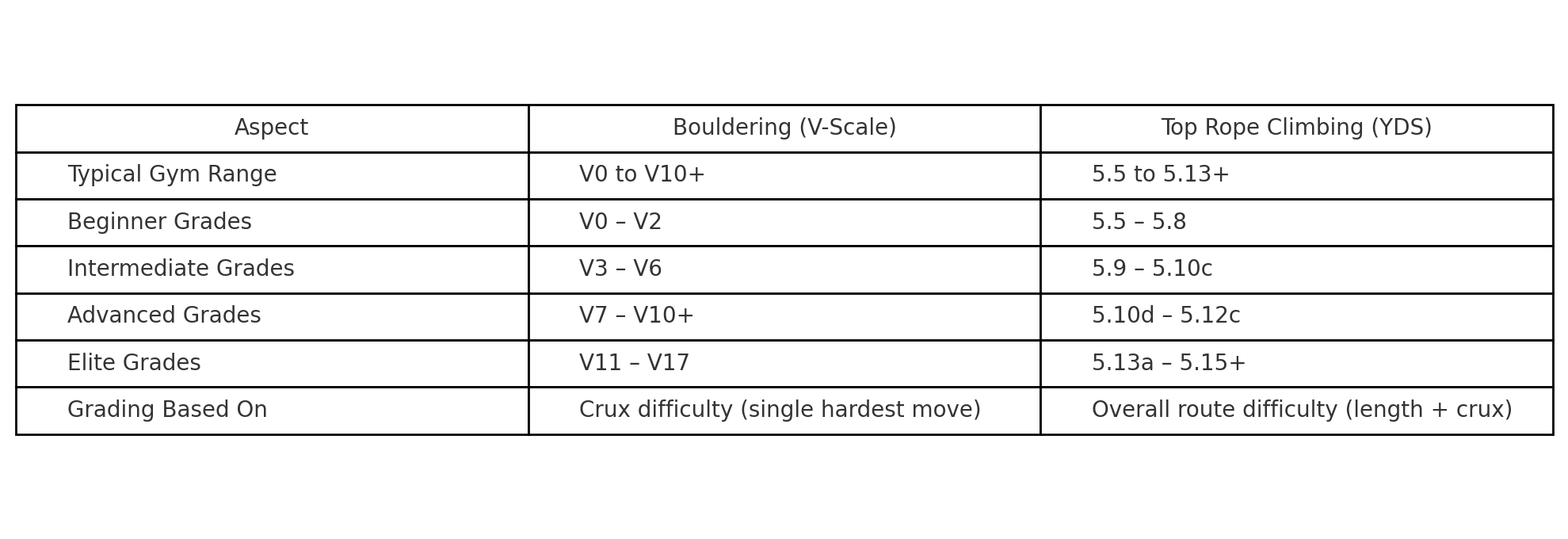Bouldering vs top rope climbing: What’s the difference?
Discover the key differences between bouldering and top-rope climbing. Learn the benefits and challenges of each to find the best fit for your climbing journey!
So you’ve caught the climbing bug. Maybe your friend dragged you to a gym “just to try it,” or maybe you watched Free Solo and thought, “Huh… I could totally do that” (spoiler: not like that, please).
Now you’re staring at two wildly different walls at your local climbing gym—one with ropes dangling from the ceiling, the other with chalky crash pads and climbers launching themselves like caffeinated spiders.
Welcome to the eternal climbing question: bouldering vs. top rope. What’s the actual difference—and which one should you try first?
Don’t worry, we’ve got you.
This guide breaks down everything you need to know: the gear, the vibes, the muscles you’ll use (hello, forearms), and even the grading systems that’ll make you feel like you're doing math homework in spandex.
Let’s climb into it.
.jpg)
Source: pressfoto on Freepik
What is bouldering?
Think of bouldering as climbing stripped down to the basics: no ropes, no harness, no partner needed.
You climb short walls (usually 10 to 15 feet high) with just your shoes and chalk, and when you fall, you land on a thick crash pad below. The focus isn’t on climbing high—it’s on solving “problems,” which are short sequences of powerful, technical moves.
Each problem is like a mini puzzle for your body: it might test your grip strength, balance, explosive power, or all of the above—in just a few moves.
It’s solo, fast-paced, and super easy to try without any setup. Perfect if you want a quick, full-body workout that feels like a game.
Source: viarprodesign on Freepik
What is top rope climbing?
Top rope climbing is what most people picture when they think of “rock climbing”—tall walls, ropes, and a harness that keeps you safe if you fall.
Here’s how it works: you’re tied into a rope that runs from your harness up to the top of the wall, loops through an anchor, and comes back down to your belay partner (or an auto-belay device). As you climb, your partner takes in slack to keep you secure.
Top rope routes are usually much taller than bouldering walls—think 30 to 60 feet—and focus more on endurance, technique, and mental focus. You’ll take your time, plan your next move, and climb at a steady pace.
You do need some gear (harness, belay device, rope) and a bit of know-how or a buddy who’s certified. But it’s a great intro to vertical climbing, especially if you want to build confidence without worrying about big falls.
.jpg)
Source: pressfoto on Freepik
Key differences: Bouldering vs top rope climbing
So now that you’ve got the basics, let’s break down the real differences between bouldering and top rope climbing—side by side:
1. Gear & Setup
Bouldering:
Super simple. All you need are climbing shoes, a chalk bag, and a crash pad if you’re outside. No ropes, no harnesses, no partner. You can literally show up, warm up, and start climbing.
Top rope:
More gear, more setup. You’ll need a climbing harness, rope, belay device, carabiner, and usually a belay-certified partner. If your gym has auto-belays, you can go solo—but even then, there’s more to manage before you climb.
TL;DR:
Bouldering = show up and go.
Top Rope = gear up and partner up.
2. Wall height & fall protection
Bouldering:
You’ll be climbing shorter walls—typically 10 to 15 feet high. The idea is to climb challenging routes (called “problems”) without the need for ropes. Falls are expected, and you’ll land on thick foam mats.
Top rope:
Here, walls can go up to 60 feet or higher. Since you’re climbing much higher, you’re tied into a rope system that runs through an anchor at the top and back down to your belayer, who controls the slack. If you fall, the rope catches you almost immediately.
TL;DR:
Bouldering falls are on purpose (and onto mats).
Top Rope falls are caught by your rope and belayer.
3. Climbing style: Power vs endurance
Bouldering:
It’s like a sprint—explosive, intense, and mentally challenging. Problems usually take 5–10 powerful moves, and each one is like a little puzzle. It’s common to try the same problem again and again until you figure it out.
Top Rope:
This feels more like a marathon. Routes are longer and often require endurance, pacing, and steady breathing. It’s less about power and more about rhythm, footwork, and mental resilience as you make your way to the top.
Example:
- Bouldering might be 8 hard moves on an overhanging wall.
- Top roping could be 30 moves on a vertical face with smaller holds and longer sequences.
4. Climbing alone vs with a partner
Bouldering:
Perfect for solo sessions. You can walk in, pick a wall, and go at your own pace—no coordination required.
Top rope:
Typically a two-person job. You’ll need a belayer who knows how to manage the rope safely (or an auto-belay system if you're lucky). It’s more structured and requires communication and trust between climber and belayer.
TL;DR:
No buddy? Go bouldering.
Have a partner (or auto-belay)? Go top rope.
5. Safety systems & risk
Bouldering:
Your safety comes from the padded flooring and your ability to land well. That means there’s a higher impact when you fall, especially if you’re tired or coming off an awkward move. Minor injuries (sprained ankles, sore wrists) are more common in bouldering.
Top rope:
The rope catches you almost immediately after a slip, so falls are low-impact. As long as your belayer is doing their job right, it’s one of the safest ways to climb high.
TL;DR:
Bouldering feels “scarier” for some because you know you’ll fall. Top rope feels safer because you’re literally held up.
6. Grading systems: How do they compare? 
Bouldering:
Uses the V-scale, which starts at V0 (beginner) and goes up to V17 (pro-level insanity). The grading is based on how difficult the individual problem is—from power to balance to body positioning.
Top rope:
Uses the Yosemite Decimal System (YDS), starting at 5.5 (easiest in a gym) and going up to 5.15+. These routes are graded based on overall difficulty, length, endurance, and technicality.
⚠️ These grading systems don’t translate directly. A V3 and a 5.10 are not equivalent—but both could feel challenging in their own ways.
.jpg)
Source: Pexels
Pros and cons of bouldering and top rope climbing
Still not sure which style is more your jam? Let’s lay it all out—the good, the challenging, and what to expect—so you can decide what works best for your goals, personality, and energy levels.
1. Bouldering: Pros & cons
✅ Pros
- Easy to start: Just rent shoes and go. No need to learn knots or belaying.
- Solo-friendly: You don’t need a partner, so it’s perfect for drop-in workouts.
- Time-efficient: Great for quick sessions—get a full-body workout in under an hour.
- Improves strength + technique fast: Forces you to focus on body tension, grip, and smart movement.
- Low commitment: You can try one problem, take breaks, and come back to it later.
❌ Cons
- Higher fall risk: You will fall—and even with mats, it can be jarring or result in minor injuries.
- Short climbs: No epic 50-foot sends here—just compact, challenging puzzles.
- Can feel intimidating: Bouldering gyms sometimes feel intense, especially if people are flashing V10s like it's nothing.
- Plateaus hit hard: Once you start progressing, it gets way harder fast.
2. Top rope climbing: Pros & cons
✅ Pros
- Safer falls: You’re secured by a rope and caught instantly if you slip.
- Great for beginners: Gives you time to think, rest on the rope, and focus on footwork and balance.
- Builds endurance: Longer routes mean more sustained effort and cardio-style training.
- Teamwork: Great for building trust and communication with your climbing partner.
- Less intimidating at first: The rope adds a sense of security—especially if heights make you nervous.
❌ Cons
- Requires more gear and setup: You’ll need a harness, rope, and a belay partner (or an auto-belay).
- Slower pace: Tying in, belaying, and taking turns takes time. Not ideal for a super fast workout.
- Learning curve for belaying: You’ll need to take a class or get certified before you can belay a partner.
- Less freedom: You’re often dependent on gym availability or someone to climb with.
.jpg)
Source: pressfoto on Freepik
Which one should you try first?
Honestly? There’s no one right answer—but here’s how to figure out which climbing style is the better starting point for you.
1. Try bouldering first if:
- You just want to walk in and start climbing—no gear, no partner, no hassle.
- You’re into quick, intense workouts and love a good physical challenge.
- You like problem-solving and don’t mind falling a few (okay, a lot of) times.
- You’ve only got an hour to spare and want to get moving, fast.
Bouldering is also great for people who are a bit impatient—since it doesn’t involve any belay setup, you can get straight into it.
2. Try top rope first if:
- The idea of falling off a wall freaks you out a little and you want the rope safety net.
- You enjoy more structured activities or working with a partner.
- You’re building confidence and want to take your time figuring out each move.
- You’re in it for the experience, not just the workout.
Top rope is perfect if you’re looking for a more controlled intro into climbing—especially if you’re okay learning to tie knots and communicate with a belay partner.
3. Still not sure?
Try both! Most gyms offer intro packages where you can sample bouldering and top rope in one visit. A lot of climbers end up loving both for different reasons—bouldering for the quick sessions and strength gains, top rope for the flow and height.
You don’t have to choose a side. (Unless you get really into it, and then… well, you might.)
[tip]
💡 Pro tip: If you’re heading to a climbing gym for the first time, chances are they use booking and scheduling software behind the scenes—like Rezerv. It helps gyms manage classes, rentals, memberships, and more—so your experience feels smooth from the moment you book to the second you chalk up.
[end-tip]
Conclusion
At the end of the day, bouldering and top rope climbing aren’t rivals—they’re just two different flavors of the same awesome sport.
Bouldering is fast, solo-friendly, and all about short bursts of strength and problem-solving.
Top rope climbing is slower, partner-based, and focused on endurance, flow, and reaching new heights (literally).
They use different gear, test different skills, and offer completely different vibes. But they both build confidence, improve your fitness, and give you that addictive sense of progress with every climb.
Still unsure? That’s okay. Most climbers don’t choose—they just do both. So don’t overthink it.
Walk into your local climbing gym, try both, and see what clicks.
Worst case? You get a fun workout. Best case? You find your new obsession.
Friska 🐨
Read next: What is Hot Yoga? What to expect, benefits, and more
.jpg)
.jpg)
